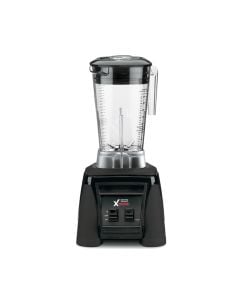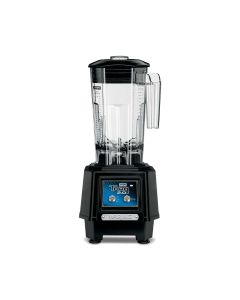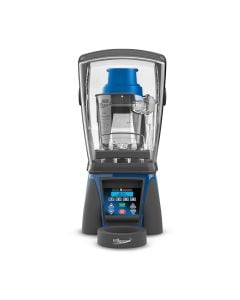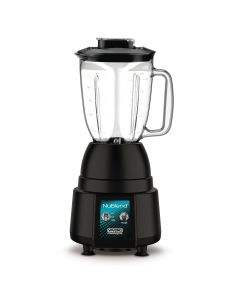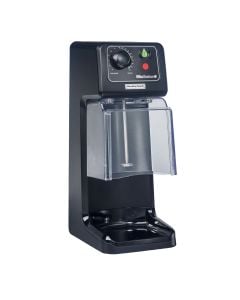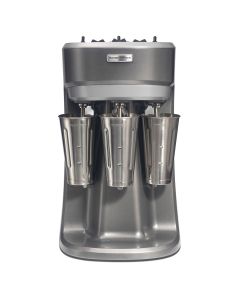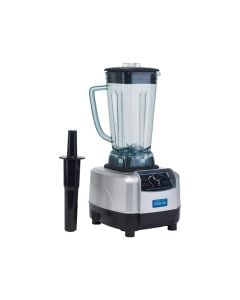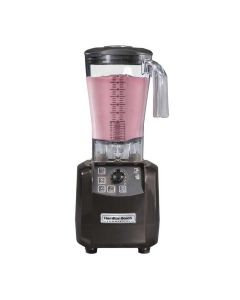Bar & Beverage Blenders
Explore a wide variety of blenders at Rapids Wholesale, including kitchen blenders, bar blenders, commercial and industrial blenders, and even home blenders. Our selection ensures you find the right blending tools and equipment for your needs, all designed for efficiency and durability in the food-processing industry.
-
Winco XLB-1000 AccelMix Blender, 68ozSpecial Price $204.99 Regular Price $239.79
A Brief History of the Kitchen Blender
The invention of the blender is often credited to Stephen Poplawski, owner of the Stevens Electric Company, who began designing blenders in 1919. Poplawski is credited to have placed a spinning blade at the bottom of a container, but his early blender was mostly utilized to create soda-fountain beverages. It wasn't until 1935 that a man named Fred Osius improved upon Poplawski's idea, creating the blender as we know it today. This, the Waring blender was born.
However, as early as 1910, Louis Hamilton, Chester Beach, and Frederick Osius had already developed a small motor that ran on either AC or DC electrical power, and that same year the Hamilton Beach Company was founded to spearhead the the development of motor-driven appliances. Innovations within the company resulted in the creation of the Hamilton Beach blender.
Today, blenders are used for a wide variety of tasks. Commercial/industrial blenders are designed for heavy-duty use and include most kitchen and bar blenders utilized in restaurants. For those looking for a simple blender for home use and not those heavy-duty blenders, there are a lot of simple, effective, but cheap blenders that are also durable enough to be used at home.
How Do Commercial Blenders Work?
To understand how our humble kitchen blender works, we need to look at the components, which are pretty basic and are somewhat uniform regardless of brand, type, and model. These components include th following: housing, blade, jar, gasket or seal ring, jar base or jar nut, and lid.
The base of the blender is where the motor is housed and where the all-important blade juts out. The blender's base is also the location of the controls for the blending process. In most blenders, the blade is permanently attached to the base. In the case of the gasket, which mostly prevents leaking, it is usually a separate piece that can be attached to the blender, as with the jar and lid.
Imagine a bar blender used to prepare a cocktail. You add the ice, liquor, mixer, and maybe some fruit to the blender jar, you attach it to the blender base, and then you push a button or flip a lever. The motor of the blender begins to turn, spinning the blade. The whirring motion creates the necessary vortex to pull the ingredients into the center of the blender's blade, crushing/liquifying them. This, in a nutshell, is how a blender works.
The Proper Way to Clean an Electric Blender
To make sure that your kitchen blender or bar blender is always in perfect working condition, you must make the necessary steps to properly clean it. Although a commercial blender or industrial blender works at least twice as hard as an ordinary home blender or mini blender, the proper cleaning process is fairly uniform across blender types.
So how should you clean your blender? First, you will want to take the blender apart by removing the base and the lid, then unscrewing the gasket and blade. Next, wash the jar, lid, gasket, blade, and seal ring by using warm water mixed with dish-washing soap. Make sure to take extra precaution on washing the blade because of its sharp edges. You can then proceed to dry all the components of the blender that you just washed. When dry, reassemble the blender and use as needed.
The Best Bar Blenders Available at Rapids Wholesale
Here at Rapids Wholesale, you can choose from a wide variety of blenders. We offer kitchen blenders, bar blenders, and both commercial blenders or industrial blenders as well as home blenders. Our blenders and other blending tools and equipment are manufactured by the most trusted names in the food-processing business: Bar Maid, Hamilton Beach, San Jamar, Tablecraft, and Waring.
Overview of Bar Blenders
There are many types of blender machines available, from compact home models to powerful industrial blenders designed for heavy-duty use. A restaurant blender or commercial blender is built for frequent, high-volume blending and is ideal for bars, cafés, and professional kitchens. For occasional use, lighter models still provide reliable performance at home.
Selecting the right blender commercial option depends on your needs—whether it’s smoothies, sauces, or high-volume frozen drinks. The right choice ensures durability, efficiency, and consistently smooth results.
A Brief History of the Kitchen Blender
The invention of the blender is often credited to Stephen Poplawski, who began designing early blender machines in 1919. His design featured a spinning blade at the bottom of a container and was mainly used to prepare soda-fountain drinks. In 1935, improvements to this idea led to the creation of the modern commercial blender, making it a versatile tool for kitchens, bars, and restaurants.
The development of small electric motors was also key to the progress of blender machines. Over time, advances in motor technology and jar design allowed the restaurant blender and industrial blender to become essential appliances for both professional foodservice operations and home kitchens.
Today, blenders are used for a wide variety of tasks. A blender commercial model is typically designed for heavy-duty blending, such as crushing ice or preparing large batches of drinks in restaurants and bars. For home use, lighter models provide simple, affordable solutions for everyday blending needs.
How Commercial Blenders Work
A blender machine, whether used as a restaurant blender or for home cooking, consists of a few basic parts: the housing, blade, jar, gasket or seal ring, jar base, and lid.
The motor, located in the base, spins the blade at high speed. As the blade turns, it creates a vortex that pulls ingredients into the center, chopping and liquefying them. The jar holds the ingredients, the gasket prevents leaks, and the lid keeps everything contained.
For example, in a bar setting, a commercial blender is often used to prepare cocktails. Ice, liquor, mixers, and fruit are added to the jar, then blended into a smooth, consistent drink in seconds.
Proper Cleaning of Electric Blenders
Keeping a blender commercial or industrial blender clean ensures top performance and durability.
To clean properly, disassemble the jar, lid, blade, and gasket. Wash each piece in warm, soapy water, taking extra care around the sharp blades. Dry thoroughly before reassembling. Whether you’re maintaining a restaurant blender that runs all day or a smaller home model, regular cleaning is essential for hygiene and function.
Beverage Blenders
Beverage blenders — also known as drink blenders, bar blenders, or commercial smoothie makers — are designed for high-volume environments where blended drinks are a menu staple. Unlike a small blender for smoothies that might be used at home, these machines are built to crush ice, blend frozen fruit, and process dense ingredients quickly and efficiently.
Whether you’re running a smoothie bar, café, or cocktail lounge, a smoothie commercial machine ensures consistent texture and flavor for every serving. Beverage blenders are also engineered for durability, making them ideal for constant use during busy service hours.
Key Applications:
- Smoothies and protein shakes
- Frozen cocktails (margaritas, daiquiris, piña coladas)
- Iced coffee and frappes
- Fruit and vegetable-based blended drinks
Common Features of Beverage & Drink Blenders:
- High-performance motors to crush ice and frozen fruit without strain
- Durable jars (polycarbonate or stainless steel) to withstand heavy use
- Sound enclosures for quieter operation in front-of-house settings
- Variable speed controls for precision blending
- Bar-friendly designs compact enough for countertops
Malt Mixers
A malt mixer is a specialized machine built to create classic milkshakes and malts with the perfect smooth and creamy texture. Unlike standard bar blenders, a commercial milkshake machine uses spindles to mix ice cream, syrups, and milk in tall mixing cups, allowing for better aeration and consistency.
These machines, also called milkshake makers or milkshake mixers, are staples in diners, ice cream shops, and restaurants. With durable construction and powerful mixing action, milkshake equipment commercial models are built for long-lasting performance in high-volume settings.
Key Applications:
- Milkshakes and malts
- Flavored ice cream drinks
- Blended dessert beverages
Common Features of Malt Mixers:
- Multiple spindles to make more than one shake at a time
- Heavy-duty motors for continuous use
- Easy-clean mixing cups for quick service turnover
- Simple controls for consistent results every time
- Compact footprint for countertop use in diners, cafés, and ice cream parlors
Food & Beverage Blenders
When versatility and power are required, a high power blender is the solution. These food and beverage blenders go beyond simple drink preparation and are capable of handling a wide range of culinary tasks. From blending soups and sauces to crushing ice for cocktails, these blenders are the workhorses of professional kitchens.
Unlike smaller models, a high power blender can process tough ingredients like nuts, seeds, and fibrous vegetables with ease. This makes them essential for chefs and bartenders who want one machine that can handle both food prep and drink service.
Food and beverage blenders typically feature heavy-duty motors with high wattage, allowing them to power through dense ingredients while maintaining consistent performance. Many include large-capacity jars, making them suitable for batch preparation in busy kitchens. Variable speed and pulse controls give operators greater flexibility for achieving precise textures, whether they’re pureeing soups, crushing ice, or blending sauces. The blades are designed for durability and efficiency, ensuring smooth results even with challenging ingredients. Their versatility allows these blenders to serve as both a bar blender for drinks and a food prep tool for the kitchen, making them a valuable all-in-one solution for restaurants, hotels, and catering operations.
If you’re looking for a wider selection of models specifically designed for food preparation, explore our full lineup here:

